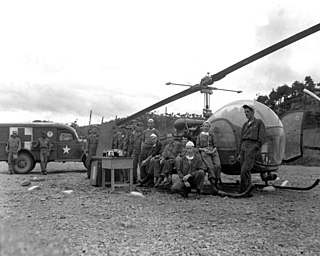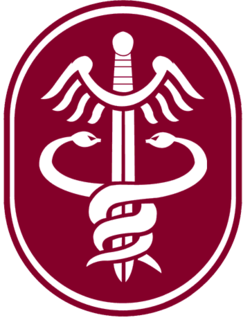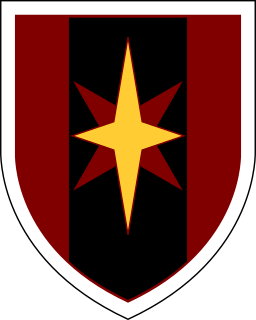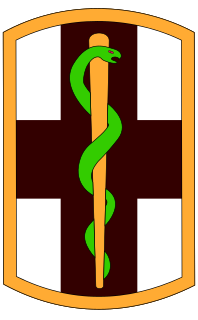
The Mobile Army Surgical Hospital (MASH) refers to a United States Army medical unit serving as a fully functional hospital in a combat area of operations. The units were first established in August 1945, and were deployed during the Korean War and later conflicts. The term was made famous in the novel, movie, and television series M*A*S*H, which depicted a fictional MASH unit. The U.S. Army deactivated the last MASH unit on February 16, 2006. The successor to the Mobile Army Surgical Hospital is the Combat Support Hospital.

The U.S. Army Medical Command (MEDCOM) is a direct reporting unit of the U.S. Army that formerly provided command and control of the Army's fixed-facility medical, dental, and veterinary treatment facilities, providing preventive care, medical research and development and training institutions. On 1 October 2019, operational and administrative control of all military and veteran medical facilities transitioned to the Defense Health Agency.

A combat support hospital is a type of modern United States Army field hospital. The CSH is transportable by aircraft and trucks and is normally delivered to the Corps Support Area in standard military-owned demountable containers (MILVAN) cargo containers. Once transported, it is assembled by the staff into a tent hospital to treat patients. Depending upon the operational environment, a CSH might also treat civilians and wounded enemy soldiers. The CSH is the successor to the mobile army surgical hospital.

A field hospital is a temporary hospital or mobile medical unit that takes care of casualties on-site before they can be safely transported to more permanent facilities. This term was initially used in military medicine, but it is inherited to be used in disasters and other emergency situations.

The Army Medical Department of the U.S. Army (AMEDD), formerly known as the Army Medical Service (AMS), encompasses the Army's six medical Special Branches. It was established as the "Army Hospital" in July of 1775 to coordinate the medical care required by the Continental Army during the Revolutionary War. The AMEDD is led by the Surgeon General of the U.S. Army, a lieutenant general.

The 67th Combat Support Hospital was the only forward deployed combat support hospital in Europe with both warfighter support and community service missions. Medical readiness was the primary concern for the unit. Located in the heart of the European theater, the 67th Combat Support Hospital stood ready to provide Echelon III health care around the globe.

In the United States Army, Medical Detachments, popularly known as Forward Surgical Teams (FST), are small, mobile surgical units. A functional operating room can be established within one and a half hours of being on scene and break down to move to a new location within two hours of ceasing operations.

The 44th Medical Brigade is a US Army unit located at Fort Bragg, North Carolina, providing health care and medical services to the Fort Bragg community, and continuing training in its combat support mission.

The 59th Medical Wing (MDW) is the U.S. Air Force's largest medical wing and is the Air Force functional medical command for Joint Base San Antonio (JBSA). It comprises seven medical groups across San Antonio. Three are located at the Wilford Hall Ambulatory Surgical Center (WHASC); the 959th Medical Group is located at San Antonio Military Medical Center (SAMMC), JBSA-Fort Sam Houston; the 59th Training Group - the wing's newest group, activated on 4 January 2016, is also located at JBSA-Fort Sam Houston. The 359th and 559th Medical Groups are located at and support the missions of JBSA-Randolph and JBSA-Lackland, respectively.

The 115th Field Hospital is a field hospital of the United States Army formed in 1917 and perpetuated until today. The hospital has participated in World War I, World War II, Desert Storm, Operation Iraqi Freedom and Operation Enduring Freedom (Afghanistan). As of March 2019, the 115th Combat Support Hospital reorganized and re-designated as a field hospital and is now a component unit of the 32d Hospital Center.

This article incorporates public domain material from websites or documents of the United States Army.

The 807th Medical Command is headquartered at Fort Douglas in Salt Lake City, Utah and manages all the Army Reserve deployable field medical units west of Ohio. There are over 11,000 Soldiers that comprise 116 subordinate units in the command. The command is separated into five brigades. While the 3rd MCDS covers the MTOE Reserve medical units to the east and ARMEDCOM provides command and control for all the Table of Distribution and Allowance (TDA) medical units within CONUS.

The 3rd Medical Command (MCDS) or "Desert Medics" is headquartered in Atlanta, GA and manages all the Army Reserve deployable field medical units east of Ohio. While the 807th MCDS covers the MTOE medical units to the west and ARMEDCOM provides command and control for all the Table of Distribution and Allowance (TDA) medical units within CONUS.
The PROFIS or Professional Filler System is used by the United States Military to fill voids in personnel when a unit deploys on a combat or humanitarian mission. Due to the high financial cost of employing physicians, civil engineers, lawyers or other "high dollar specialists" in a military unit, usually at the battalion and sometimes at the brigade level a full time "specialist" is not permanently assigned to these units. When a unit deploys to an austere location, the demand for a specialist increases. The military's solution is to have a PROFIS or assigned specialist to these units that only serves with the unit when they deploy.

The 28th Combat Support Hospital was a Combat Support Hospital of the United States Army. It was first constituted in 1943 and served in China during World War II. During the Gulf War in 1990, it was the first Army hospital unit established and deployed into Iraq with combat forces of the XVIII Airborne Corps. More recently it has been involved in relief operations following natural disasters and has undertaken several recent deployments to Iraq. The unit fell under the command of the 44th Medical Brigade and was based at Fort Bragg, North Carolina.

The 274th Forward Surgical Team (Airborne)—part of the 274th Forward Resuscitative and Surgical Detachment (Airborne)—is an airborne forward surgical team of the United States Army providing Level II care far forward on the battlefield. It was first constituted in 1944 and served in Europe during World War II. More recently it has been involved in relief operations following natural disasters and has undertaken several recent deployments to Iraq and Afghanistan. The 274th Forward Surgical Team was part of both the initial entry forces of Operation Enduring Freedom in 2001 and Operation Iraqi Freedom in 2003. Currently the unit falls under the command of the 28th Combat Support Hospital and is based at Fort Bragg, North Carolina.
The 109th Military Intelligence Battalion is a multidiscipline Military Intelligence battalion of the United States Army headquartered at Joint Base Lewis-McChord, Washington. A Regular Army Military Intelligence Battalion, it is one of the subordinate battalions of the 201st Expeditionary Military Intelligence Brigade, which is part of the US Army's I Corps..

The 14th Combat Support Hospital is a combat support hospital of the United States Army. It participated in World War II, the Korean War and, more recently, deployed to Afghanistan. Additionally, it was involved in the relief operations following Hurricane Katrina. The unit currently falls under the command of the 44th Medical Brigade and is based at Fort Benning, Ga and relocating to Fort Stewart, GA during FY 2020.

The 1st Medical Brigade is a medical brigade of the United States Army. It is located at Fort Hood, Texas, providing health care and medical services to the Fort Hood community, and continuing training in its combat support mission.

















